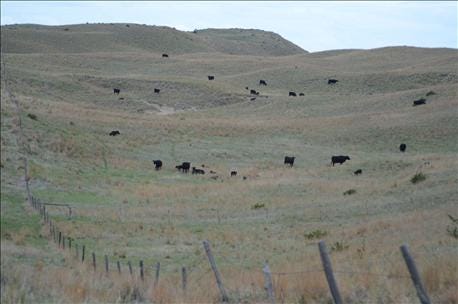
Many Sandhills ranchers have heard the story. According to the Nebraska State Historical Society, the first ranch in the region was established in 1877 by E.S. Newman near the Niobrara River. Newman and his fellow ranchers initially steered away from the Sandhills, believing the region, with shifting sand dunes and few known sources of water, wouldn't support cattle. In the winter of 1878, storms drove cattle south into the Sandhills. Newman and his fellow ranchers had to venture into the Sandhills to roundup the cattle the following spring, and found the cattle had shelter and plentiful grass and water in the hills.

This post marks the third in a series of blog posts devoted to Beef Month. Last week marks the 76th annual Sandhills Cattle Association Convention, and during that time, I've had the privilege of meeting beef producers whose cattle graze some of Nebraska's most scenic terrain.
The Sandhills Cattle Association, established in the 1930s, is made up of about 1,300 members, most of them Sandhills graziers, although some are located in adjacent states and have a preference for buying cattle fattened up on Sandhills grass. "I've gone through a lot of old files and found some of the original charter members," says Katie Kubacki, manager of SCA. "It's interesting because some of our charter members have grandchildren ranching in the Sandhills that are now SCA members."
Prime cattle country
The region is well-known as one of the top cattle-producing regions, and it isn't hard to see why. While the sandy soil makes the region unsuitable for crop farming, it's ideal for cattle grazing.
The sea of grass that is the Sandhills covers 20% or more of the state. Yes, the Sandhills are covered in sand dunes, but they're held in place by mixed grass prairie. This includes a range of species, many of which are endemic to the region and suited to a sandy environment, including little bluestem, sand bluestem, hairy grama, blue grama, and sand lovegrass.
As several ranchers have pointed out this last week, the introduction of cattle traffic has helped anchor the dunes, control undesirable plant species, and allowed desirable vegetation to thrive. Over the years, the region has acquired a thicker cover of grass, according to the State Historical Society. "It's improved so much thanks to grazing cattle," Kubacki says. "It's important to show people who have the misconception that agriculture is detrimental to the land that we've actually improved it."
It's an often-cited fact that cattle outnumber Nebraskans by almost four to one – even more so in the Sandhills, one of the most sparsely-populated regions of the lower 48 states. Meanwhile, three Sandhills counties, Cherry County, Custer, and Holt, boast the title of the top three beef cow counties in the U.S., with 166,000, 100,000, and 99,000 head, respectively. "Some of the most well-known ranches are in the Sandhills," Kubacki says. "It's really a prime spot for cattle."
For more information, visit www.sandhillscattle.com. Be sure to check out other Beef Month blog entries, Nebraska's cowtown history and May is Beef Month.
About the Author(s)
You May Also Like






